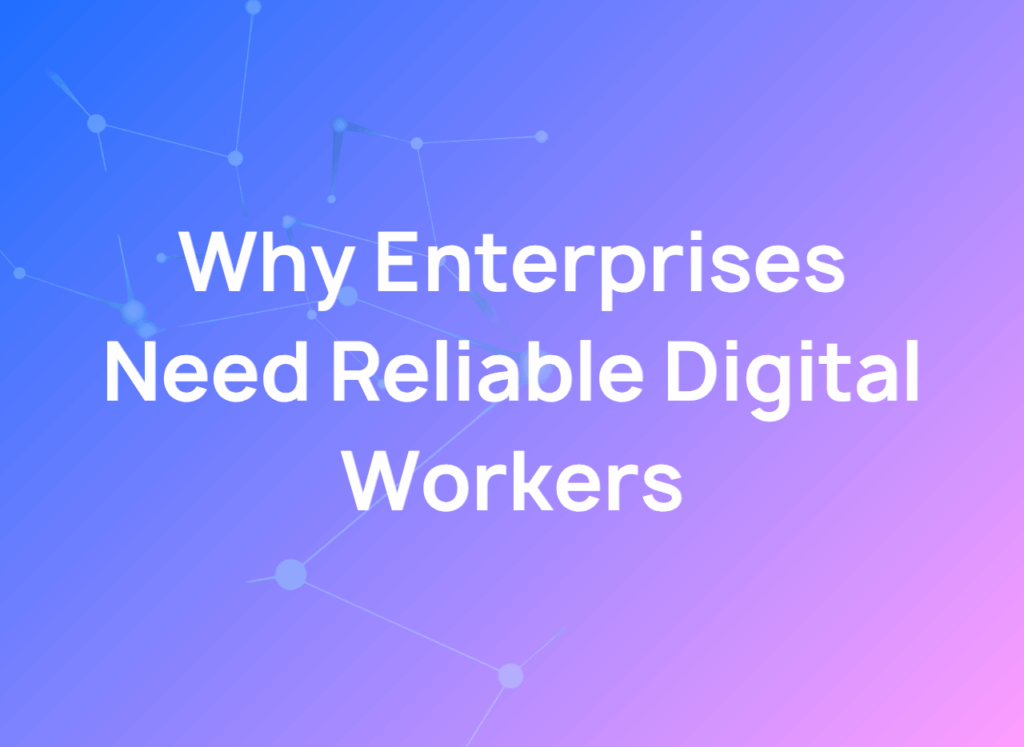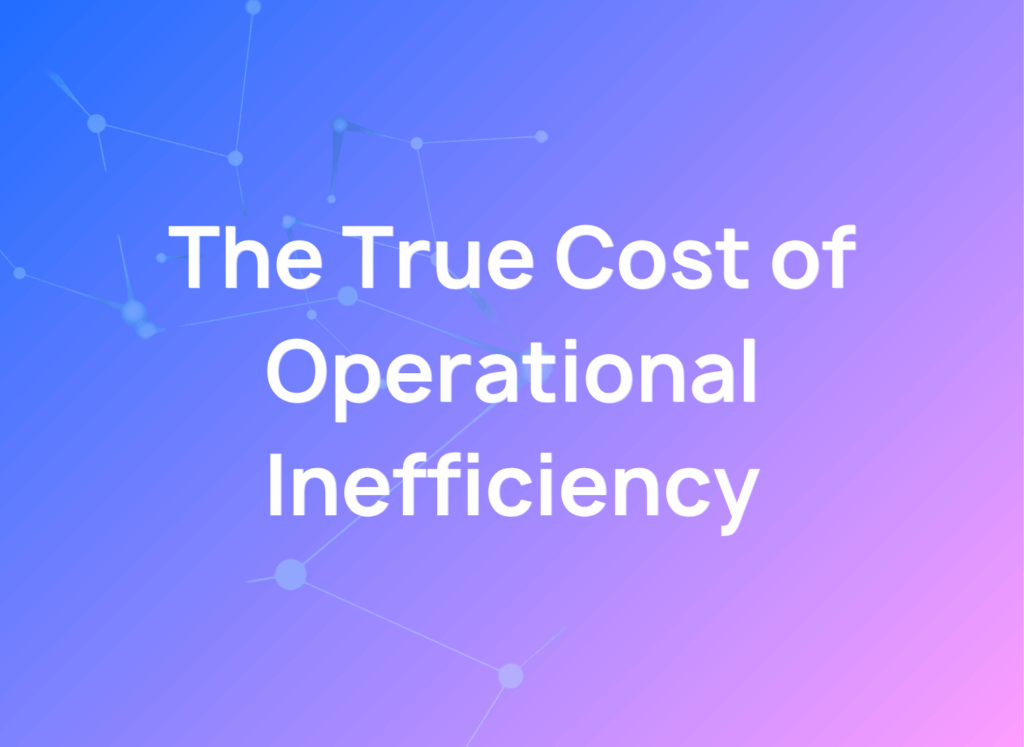How Digital Workers Help Identify Workflow Inefficiencies
How Digital Workers Help Identify Workflow Inefficiencies
Operational inefficiencies are often hidden in plain sight—manual processes, unnecessary approvals, rework, and lagging communications that quietly drain time and resources. For senior executives tasked with driving efficiency and hitting KPIs, these inefficiencies pose a significant challenge. Yet identifying these pain points can feel like searching for a needle in a haystack, especially in complex business systems.
That’s where Digital Workers offer a game-changing solution. These AI-powered agents specialize in shining a light on inefficiencies, automating repetitive tasks, and generating actionable insights in real time. By identifying and addressing workflow bottlenecks, Digital Workers help businesses unlock new levels of productivity and operational excellence.
Here’s how they can help operational leaders pinpoint workflow inefficiencies, streamline operations, and achieve more with less.
Understanding Workflow Inefficiencies
Workflow inefficiencies often stem from processes that are outdated, overly manual, or poorly integrated. While they may not always be obvious, the effects are undeniable:
- Delays in decision-making
- Increased error rates
- Higher operational costs
- Reduced employee engagement and productivity
Inefficiencies like redundant data entry, disconnected systems, or manual reporting cycles all add friction to daily operations. For strategy and operations executives, solving these bottlenecks is critical to optimizing performance and achieving KPIs.
Why Traditional Methods Fall Short
Identifying inefficiencies using traditional methods—such as manual audits or consultant-led reviews—is time-consuming, resource-intensive, and prone to bias. These approaches often:
- Focus only on surface-level symptoms instead of systemic causes
- Require extensive manual documentation and data-sharing, which delays implementation
- Come with significant costs, especially when relying on external consultants
This is where Digital Workers stand apart, enabling organizations to pinpoint inefficiencies quickly, cost-effectively, and with a higher degree of accuracy.
How Digital Workers Uncover Workflow Inefficiencies
Digital Workers operate as autonomous AI agents that integrate seamlessly into your systems and workflows. Equipped with advanced capabilities like real-time data analysis, process visualization, and automation, Digital Workers simplify the process of uncovering inefficiencies and transforming operations.
Here’s how they make it happen:
1. Real-Time Monitoring and Analysis
Digital Workers excel in continuously analyzing workflows for inefficiencies. They monitor data across platforms, observe task durations, and highlight areas where delays or errors are frequent.
For example:
- Identifying patterns of late invoice submissions and correlating them with delays in payment processing
- Highlighting tasks that require repeated manual intervention, creating bottlenecks in the workflow
Their ability to process and interpret data in real time ensures that decision-makers receive timely, actionable insights.
2. Process Visualization and Bottleneck Identification
Ever struggle to see the full picture of a workflow? Digital Workers map your processes end-to-end, revealing gaps, redundancies, and unnecessary complexity. By spotting areas that slow operations—like approval deadlocks or excessive handoffs—they give organizations a clear blueprint for improvement.
Example Scenario:
An operations team uses a sales approval workflow that requires cross-departmental sign-offs. A Digital Worker maps the process, showing that 80% of delays occur during manual email exchanges between finance and sales. Based on this insight, automation is applied, cutting approval times in half.
3. Automating Repetitive Tasks to Free Resources
Many inefficiencies hide within repetitive manual tasks, such as data entry or report generation. These tasks not only drain employee productivity but also create opportunities for errors.
Digital Workers automate these processes, reducing manual workloads, increasing accuracy, and freeing up staff for higher-value activities.
Key Applications:
- Automating customer order updates between CRM and ERP systems
- Generating dynamic performance dashboards instead of relying on static, manually created reports
With Digital Workers in place, teams no longer worry about low-value drudgery, allowing them to focus on strategic initiatives.
4. Cross-Platform Integration for Seamless Workflows
Disconnected systems are a common source of inefficiencies. Information silos cause delays, miscommunication, and a lack of visibility across departments. Digital Workers act as a connective tissue between platforms, ensuring data flows effortlessly and workflows remain streamlined.
Example Scenario:
A logistics company struggled with data inconsistencies between their inventory management and procurement systems. Digital Workers synced the platforms in real time, reducing errors and giving teams a unified view of stock levels without manual reconciliation.
5. Delivering Real-Time Alerts and Actionable Insights
The beauty of Digital Workers lies in their ability to provide immediate feedback. Unlike traditional audits that require weeks to compile findings, Digital Workers alert teams in real time when inefficiencies arise.
Example Use Case:
Imagine a procurement workflow where delays occur whenever purchase orders exceed a certain amount. A Digital Worker can flag these orders as soon as they trigger the delay threshold, enabling proactive resolution instead of reactive firefighting.
The Impact of Digital Workers on Workflow Optimization
When deployed to address inefficiencies, Digital Workers deliver measurable, business-critical results. Key benefits include:
- Faster Decision-Making: Bottlenecks are identified and resolved while workflows remain active, reducing lead times.
- Cost Reductions: Automating repetitive tasks eliminates additional labor costs, while fewer errors cut the cost of rework.
- Optimized Resource Use: Employees focus on strategic priorities instead of low-value tasks, maximizing organizational potential.
- Improved KPI Metrics: Faster workflows and greater accuracy result in higher performance outcomes across departments.
Consider the following success story:
- A healthcare organization deployed Digital Workers to automate patient scheduling. Inefficiencies in bookings were eliminated, reducing wait times and improving operational throughput, leading to a 20% improvement in efficiency.
Start Small, Think Big
For operational leaders looking to identify and correct inefficiencies, starting with Digital Workers offers a low-risk, high-impact approach. Unlike complex digital transformations, they integrate with existing systems and scale incrementally, allowing organizations to test their impact and expand gradually.
Steps to Get Started:
-
Map Critical Workflows
Identify key processes that involve heavy manual work or frequent delays. Start by implementing Digital Workers where the potential for impact is greatest.
- Measure Baselines
Track performance metrics, such as time spent on specific tasks, error rates, and costs, to establish a baseline before deploying Digital Workers.
- Deploy and Iterate
Launch a Digital Worker for a single workflow, analyze its results, and refine or expand its role as needed.
- Scale Across Departments
Use the success of your initial implementation to scale Digital Workers across other high-impact areas of your operations.
Final Thoughts
Workflow inefficiencies are a silent drain on resources, but they don’t have to be. Digital Workers provide a smarter, more strategic way to identify and resolve bottlenecks, driving operational excellence while empowering teams to focus on what matters most.
For operational executives seeking actionable solutions without the complexity of traditional audits or overhauls, Digital Workers offer a clear path forward. Their ability to deliver real-time insights, automate tedious workflows, and uncover inefficiencies positions them as invaluable allies in the pursuit of organizational success.
Want to take the guesswork out of identifying inefficiencies? Equip your team with Digital Workers today—and unlock the full potential of your workflows.
Take the First Step Toward Transformation
Unleash the potential of Digital Workers in your organization today. Schedule a personalized consultation to discover how these innovative solutions can revolutionize your workflows and position your business for success in the future.





